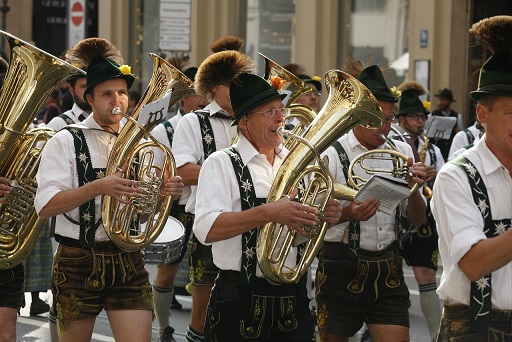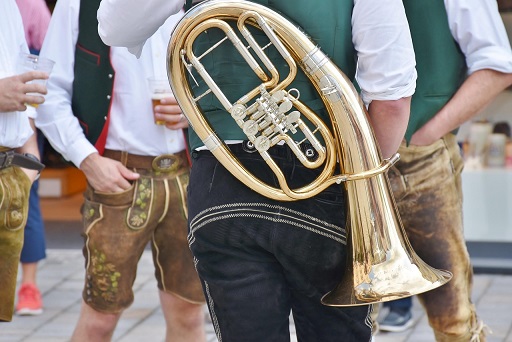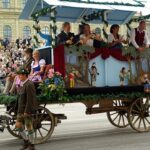
The smell of roasted almonds, the sparkle of dirndl skirts, the heft of one-liter Maß mugs – all of these form part of the Oktoberfest experience. But the moment you enter one of Munich’s famed beer tents, what strikes you first is the sound. The deep brass of tubas, the cheerful whine of clarinets, the drum beats that shake the floor. At Oktoberfest, music is more than background noise – it is the beating heart of the celebration.
This article is your all-access guide to the rich musical traditions of Oktoberfest. From the legendary oompah bands that get thousands singing in unison to the lesser-known customs of tent-specific anthems and impromptu dance floors, we explore how sound and celebration go hand in hand in Bavaria’s biggest party.
➡️ Related: What to Wear to Oktoberfest: Dirndls, Lederhosen, and Modern Tracht
The Origins of Oktoberfest Music
When the first Oktoberfest was held in 1810 to honor the wedding of Crown Prince Ludwig and Princess Therese, music was part of the pageantry from the start. Brass bands and folk ensembles entertained crowds during horse races and communal feasts.
As the festival evolved, especially in the 19th and early 20th centuries, Bavarian wind ensembles became central. Known for their lively mix of polkas, marches, waltzes, and schottisches, these bands gave rise to what we now recognize as the oompah sound – named for the rhythmic “oom-pah-pah” pattern of tubas and baritone horns.
Today, the tradition continues in full force with live bands performing daily inside the festival’s 14 large tents and 20+ smaller ones.
What Is an Oompah Band?

An oompah band typically includes:
- Brass instruments: tubas, trumpets, trombones
- Woodwinds: clarinets, flutes, saxophones
- Percussion: snare and bass drums, cymbals
- Accordion or keyboard for harmonies
- Vocalists (increasingly common)
They play a mix of traditional German Volksmusik and modern pop – often arranged in polka or waltz tempo. The real art lies in their ability to switch effortlessly from a 19th-century beer hall march to a schlager hit from the 1980s.
Beer Tents: Musical Epicenters of the Festival
Each large beer tent at Oktoberfest has its own personality – and part of that personality is musical. Some of the most famous tents include:
- Schottenhamel: Where the mayor taps the first keg, known for upbeat brass and youthful energy
- Hofbräu-Festzelt: A party tent with a strong international crowd and a high-energy band
- Augustiner-Festhalle: A favorite of Munich locals, with more traditional musical choices
- Winzerer Fähndl (Paulaner tent): Large-scale sing-alongs and iconic crowd engagement
Most bands are situated on a central platform (or bandstand) in the middle of the tent. This allows them to be seen and heard from all corners, and it helps unify the massive crowd in song and movement.
➡️ Related: Oktoberfest Beyond the Beer: Traditions You Didn’t Know Existed
From Polka to Pop: What You’ll Hear
Contrary to popular belief, Oktoberfest music isn’t just old-timey folk. The musical setlist has expanded greatly to include:
- Traditional Bavarian tunes: “In München steht ein Hofbräuhaus,” “Rosamunde”
- Schlager hits: Catchy, often cheesy German pop songs
- International anthems: “Sweet Caroline,” “Country Roads,” “Living Next Door to Alice”
- German-language rock and pop: Songs by Die Toten Hosen, Helene Fischer, Wolfgang Petry
The magic is in the mix. One moment you’re swaying arm in arm to a classic waltz, the next you’re jumping on benches singing “Ein Prosit der Gemütlichkeit!”
Ein Prosit: The Toast Heard Every 15 Minutes
No Oktoberfest experience is complete without the ritual toast: “Ein Prosit der Gemütlichkeit!”
Translation: “A toast to cheer and good times!”
Played roughly every 15 minutes in every beer tent, this short tune is the call to raise your glass, clink with your neighbors, and drink. It reinforces the communal nature of Oktoberfest and serves as a joyful reset button amid the chaos.
Dancing, Singing, and Spontaneous Joy
Oktoberfest music is participatory. There are no dance floors, but you’ll see:
- People dancing on benches (never the tables – that’s frowned upon)
- Arm-in-arm swaying during slower songs
- Clapping games for faster polkas
- Call-and-response choruses shouted by entire tents
This interactive element turns passive listeners into performers. Even first-time visitors quickly catch on, thanks to the repetitive rhythms and universal melodies.
The Bands Behind the Magic
Many Oktoberfest bands are professional ensembles who return year after year. Some even rehearse year-round or tour internationally.
Popular Oktoberfest bands include:
- Die Niederalmer
- Die Kirchdorfer
- Cagey Strings
- Münchner Zwietracht
Each tent has its “house band,” often led by a charismatic conductor who doubles as an emcee, energizing the crowd between songs.
The Technology Behind the Sound
Beer tents are massive – some seating up to 10,000 people. To ensure high-quality audio throughout:
- Bands are miked and amplified via professional sound systems
- Tents use acoustic design features (wood beams, canvas panels) to reduce echo
- Mixing engineers ensure balance between instruments and vocals
It’s not just a party – it’s a serious production.
➡️ Also read: The Oktoberfest Parade: Marching Through Bavarian History
Oktoberfest Music Outside Munich
As Oktoberfest spreads across the globe, so too does its musical tradition. Many festivals abroad import:
- German oompah bands on tour
- Local brass bands with Oktoberfest setlists
- DJ sets that mimic the Munich experience
Whether in Cincinnati, Blumenau, or Tokyo, it’s the music that bridges the cultural gap.
How to Join In Without Feeling Silly
Don’t worry if you don’t know the lyrics. The spirit of Oktoberfest is about inclusion. Here’s how to engage:
- Clap along to the beat – easy and universal
- Learn a few phrases like “Prost!” or “Noch ein Bier, bitte”
- Repeat the chorus even if it’s your first time hearing it
- Follow the locals – if they raise their arms, you do too
You’ll be singing along in no time.
Why Music Matters at Oktoberfest
At its core, Oktoberfest is about Gemütlichkeit – a warm sense of belonging and shared joy. Music is how that feeling is transmitted.
It creates:
- Emotional highs and lows that mirror the beer-fueled rollercoaster of the day
- Moments of unity where thousands sing with one voice
- A sense of timelessness, connecting past generations to the present
Without music, Oktoberfest would just be drinking. With it, it’s a cultural phenomenon.
Raise Your Glass to the Sound of Celebration
Whether it’s the brassy chorus of “Ein Prosit” or the bittersweet sway of a German love ballad, the music of Oktoberfest leaves a lasting impression. It’s festive, emotional, rowdy, and deeply rooted in tradition.
So when you next visit the Wiesn, don’t just listen. Join in. Let the music move you, lift your glass, and become part of the world’s greatest folk festival – one note at a time.
➡️ Continue your Oktoberfest journey:
- Oktoberfest Beyond the Beer: Traditions You Didn’t Know Existed
- What to Wear to Oktoberfest: Dirndls, Lederhosen, and Modern Tracht
- The Oktoberfest Parade: Marching Through Bavarian History
- Oktoberfest Origins: From Royal Wedding to Global Icon
- 14 Fun Facts You Didn’t Know About Oktoberfest
- German Beer – the Absolutely German Drink






